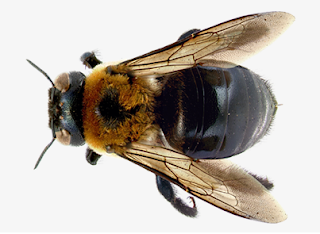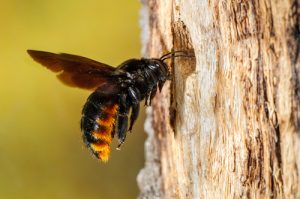Why Carpenter Bee Control is Needed
Why is carpenter bee control needed? This is a question that many
people ask and understandably so. After all, carpenter bees are not nearly as
aggressive and dangerous as wasps and hornets and they are less likely to sting
you than honey bees. So, what exactly makes them a threat and why do they need
to be eliminated? Let us take a look.
The
Problem with Carpenter Bees
First of all, it is 100% true that carpenter bees generally do not
pose a threat to human beings as in they do not attack and sting you at the
slightest of provocations like wasps or hornets do. They do, however, pose an
entirely different problem – structural damage.
Carpenter bees can cause a great deal of damage to wooden objects.
They tend to drill holes and make their nests in wooden structures. It could be
your doors, windowsills, decks, railings, roof eaves, or fences. Any wooden
structure that is sufficiently easy to drill into becomes a potential nesting
site for these bees and they will burrow themselves deep into the wood and lay
eggs there.
There are two types of carpenter bees – large and small. The large
ones are more common and they are also the ones that are likely to cause more
damage. The holes they drill are generally ½ inch wide and the tunnel they
excavate could be anywhere from 4 to 8 inches long. This is one of the reasons
why a carpenter bee infestation, if kept unchecked for a long time, could
hollow out and damage the wooden structures in your place.
Moreover, there is an aesthetic angle to the carpenter bee problem
as well. Doors, windows, and roofs ridden with holes are not a pretty sight and
they lessen the overall appeal of your property. This again is a reason why
homeowners generally try to get rid of carpenter bees as quickly as possible.
How to
Get Rid of Carpenter Bees?
Carpenter bee control generally involves a two-pronged approach –
the application of insecticide and the sealing up of the holes.
Applying an insecticide dust into the drill holes is the first
course of action. Once it is applied, the nesting site should not be disturbed
for a couple of days, during which time the bees will come into contact with
the insecticide and die. Once they are dead, the sealing up process can be
done.
Sometimes, an aerosol spray might be required to get rid of the
bees buzzing in and around the nesting site. The aerosol could also be sprayed
into the holes if required. Once all the bees are dead – particularly the
female ones, as they are the ones that are capable of stinging – the holes can
be sealed up completely.
A weather resistant caulking compound is generally what is used to
seal up the holes. Once everything is sealed up, the whole structure should be
painted with exterior paint or varnish, since carpenter bees are less likely to
damage treated wood.
If you are going to build a new wooden structure – be it a fence,
deck, roof, or anything else, it is a good idea to do so with treated wood to
minimize the risk of infestations.
Is DIY
Bee Removal a Good Idea?
No, it is not a good idea, even if you are a DIY enthusiast.
Carpenter bee control involves the application of insecticides, which require
careful handling. Moreover, there are many types of insecticides available and
only a pest control expert can decide which one to use, depending on a number
of factors.
Secondly, and more importantly, though carpenter bees are not as
dangerous as wasps, hornets, or even regular honey bees, they still are capable
of stinging, particularly when they are provoked. So, there is a good chance
you could get attacked by a bunch of bees when you try to spray the aerosol or
apply the insecticide. This is one of the main reasons why you should leave it
to the professionals.
Thirdly, any pest control treatment requires safety gear and
proper equipment, both of which you are not likely to possess unless you do it
for a living. Trying to remove or exterminate a beehive or colony without
proper equipment and safety gear is very risky and is not recommended under any
circumstances. So, it is always better to leave it in the hands of
professionally trained carpenter bee control experts.

